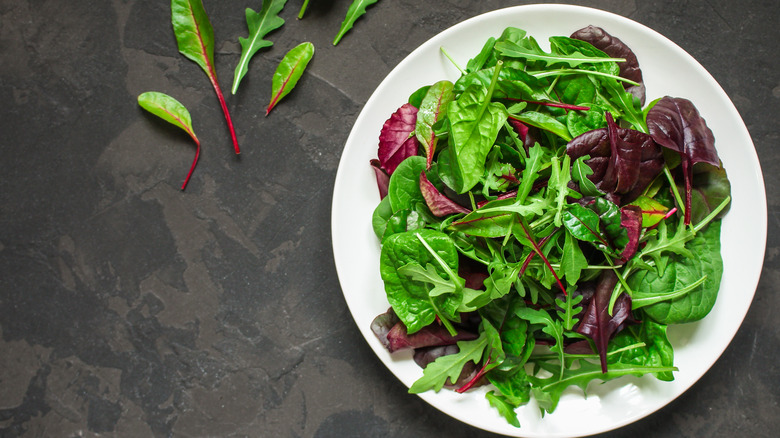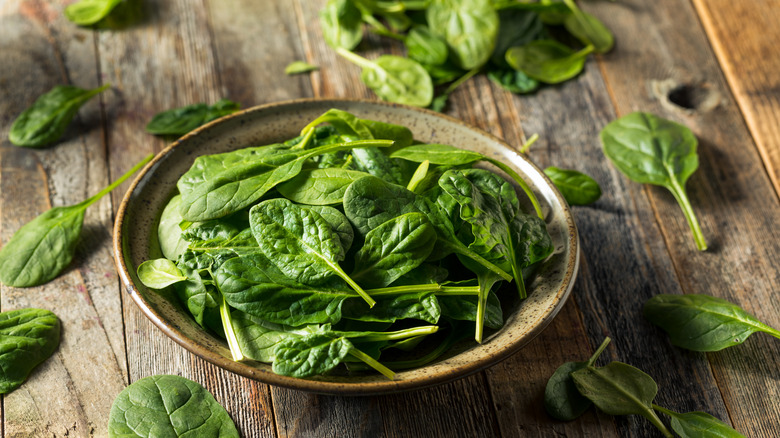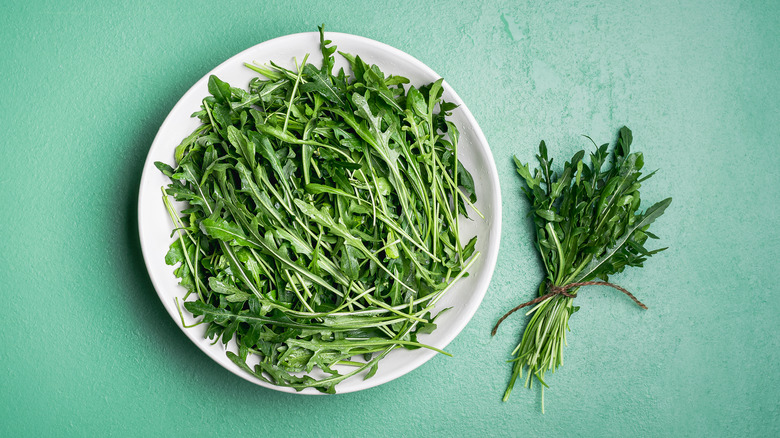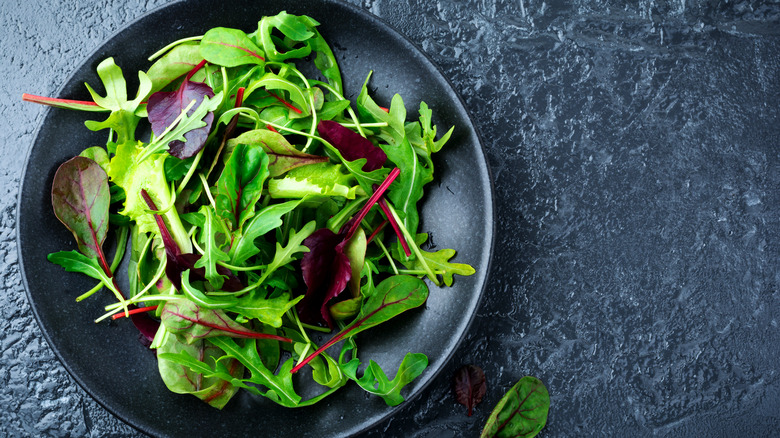Arugula Vs. Spinach: What's The Difference?
Here's the funny thing about arugula and spinach: They couldn't be more different from each other in terms of taste, nutrition, appearance, and common recipe uses, but at the same time, they can easily be substituted for one another.
Let's start at the very beginning with a few fast facts about each salad green. According to MasterClass, arugula — a popular ingredient in Italian and French cooking — belongs to the brassica family, which is also home to broccoli, cauliflower, cabbage, and collard greens. Over time, it's built a valuable reputation in the United States and even developed a nickname: garden rocket. Spinach is a very dense salad green in the goosefoot family, which is also native to Swiss chard and beets, per Sweetwater Organic Farm. It's always been a go-to salad green, and has become increasingly popular in pastas, pizzas, and baked casseroles.
Each veggie has characteristics that lend a better hand over the other in the kitchen. Ahead, we break those all down so you know exactly when to use arugula versus spinach, and when it's appropriate to substitute one for the other. Spoiler alert: It almost always is.
Arugula vs. spinach: How do their tastes compare?
Arugula and spinach couldn't taste any more different. For starters, arugula has a very distinct flavor, which is usually described as peppery. The website went on to explain that as arugula leaves continue to mature, their taste can also become bitter. Grown arugula can add a tartness to your meal; however, baby arugula is more delicate and mild. Fun fact: you can eat mature arugula seeds!
Spinach is interesting because its flavor varies; it's dependent on the way it's prepared and consumed. Raw spinach (for instance, as it's often found in salads) is mild and can have a light sweetness to it. This makes it a refreshing, crisp salad green. When cooked (i.e. sautéed, baked, and so forth), spinach has a stronger presence and can taste acidic and robust.
The two couldn't be more different, but they each bring so much to the table — literally.
Spinach and arugula can be used interchangeably, but there are consequences
Because of its strong peppery flavor, arugula is commonly used as an "accent" or garnish on sandwiches, pastas, pizzas, or soups. It's there for show and because it tastes good, but at the end of the day, the meal would survive without it. Spinach, on the other hand, is typically a main feature in a dish. Think: creamed spinach, or stuffed spinach ricotta shells. Without it, you'd notice its absence. However, the two can be used interchangeably, meaning you can substitute one for the other. Unlike dairy products, spinach and arugula won't alter too much. Just keep in mind that the greens have different textures and tastes, so the flavor or feel of your meal may be a little different than what you were originally going for.
With its leafier, fuller body, spinach is often preferred for salads. Plus, it packs more substance. Spinach alone can act as a salad base, whereas you'd probably need another leafy green or two if you wanted an arugula salad. This is called a blended salad. Arugula is very lightweight, which has its perks, but it can also get lost among salad toppings, especially if there's meat.
Which green is the healthiest?
When it comes to nutrition, arugula doesn't stand a chance against spinach. That isn't to say that it's unhealthy or bad for you; spinach just offers more nutritional benefits, especially where vitamins are concerned.
According to Harvard Health Publishing, arugula's nutritional tally is 237 international units of vitamin A; 11 micrograms of vitamin K; 16 milligrams of calcium; and five milligrams of magnesium. Arugula also has a very high potassium count, at 37 milligrams.
On the flip side, spinach has nearly 12 times the amount of vitamin A. Likewise, the salad green has eight micrograms of vitamin C (arugula only has 1.5); 144 micrograms of vitamin K; 30 milligrams of calcium; and 24 milligrams of magnesium. Additionally, spinach has four and half times the amount of potassium and 58 micrograms of folate while arugula only has 10.
Again, these numbers don't mean arugula is a waste of a green. Rather, you can use this information to help determine what green would be best for your meal. Maybe you need to eat foods rich in vitamin A or decrease the amount of potassium in your diet.



